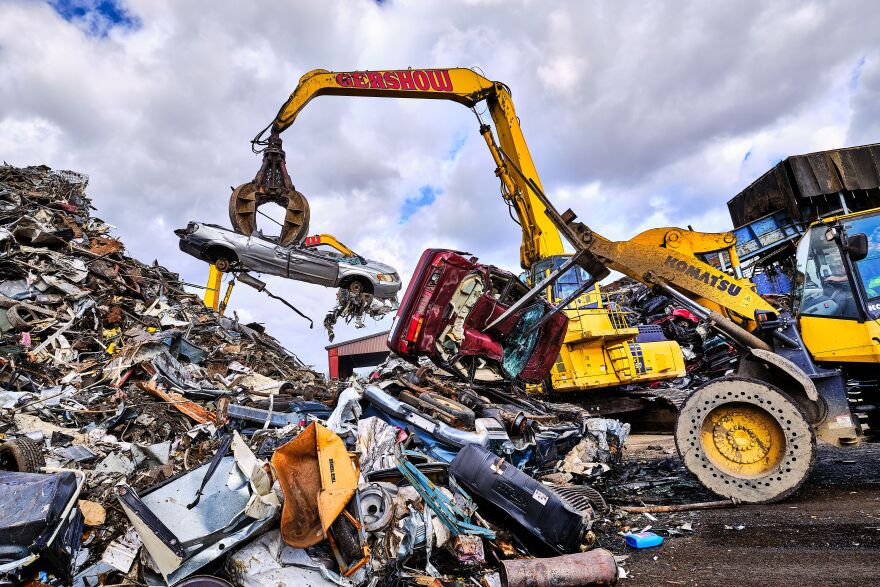You might think of “reusing” and “recycling” as relatively new concepts. But, between 1900 and 1960, thousands of scrap dealers were listed in the Milwaukee City Directory. Up to 90% were Jewish businesses.
The Jewish Museum Milwaukee's exhibition called Scrap Yard: Innovators of Recycling tells their story. The exhibition comes from the Jewish Museum of Maryland and the Jewish Museum of Milwaukee added Wisconsin stories.
Curator Molly Dubin says there wasn’t even enough room to list all the junk dealers, rag pickers and haulers. “So [we] had to introduce a couple of criteria, the last one we did was it had to have been in business for two years, which brought us down to just short of 400,” Dubin says.
A video helps visitors understand what Dubin calls the complexity of a scrap yard. It reveals a working yard in Maryland. “If you’ve gone to a scrap yard you know it’s a massive space because of the sheer volume they deal with. The yard also looks a bit chaotic because there is so much there and so many steps—sorting, processing, etc.” Dubin says.
The Jewish Museum of Maryland created the film and the exhibition that surrounds it, even sending along a full-size motorbike. The display breaks down its components made of metal, plastic, rubber —and how they might be repurposed.
“One of the reasons they wanted to include this is to show you really the scrap industry affects everything that we handle. Everything that we touch, everything that we come into contact with, and that every item can be broken into raw materials that can be reused, reprocessed, recycled — hopefully the majority of it — some cannot depending on what the material is,” Dubin says.

Dubin says looking into the scrap industry is in keeping with the mission and topics the museum explores, “ Which has to do with immigration and early business, and certainly environmental justice...this really shows you some of that at work here,” Dubin says.
Peddlers, Dubin says, were the original recyclers. As eastern Europeans made their way to America, peddling put food on families’ tables. They sold scraps to mills and factories. In fact, Dubin says, immigrant collectors, peddlers, and dealers followed the industrial revolution as it moved across North America, bartering and creating trade networks along the way.
“You need[ed] very little money, you didn’t necessarily need to know the language and it wasn’t something that really existed. So because of that entrepreneurial spirit that we find also as a commonality — in many of the immigrants and Jewish immigrants — this was something they could make their own unique niche and develop and grow, which is what they did,” Dubin says.
The niche came with stereotypes, some positive, others not. The exhibit explores both.
“Yiddish theater shows, like Schmattes which means rags in in Yiddish. But there were also negative, depicting Jewish individuals who were scrapers in raggy clothing, as dirty, as lesser than. The larger or hooked noses. And this perpetration of these Jewish individuals as being untrustworthy,” Dubin says.

But during war time, especially World War II, when scrapping was critical to U.S. efforts, Dubin says the stereotype shifted.
“It was promoted as this kind of patriotic campaign. Everyone do your part, victory rallies to collect scrap, and all of a sudden this stereotype that skewed fairly negatively starts to become somewhat heroic,” Dubin says.
Dubin says scrapping was grueling work. “[It] took them away from their families from early in the morning until late at night, sometimes seven days a week unless they figured out a way they could be closed for Shabbat,” Dubin says.
Dubin enters a room featuring Wisconsin scrappers, and reads a memory shared by a peddlar’s descendent.

“Phil Paley, he worked for Miller Compressing. ‘My mother always tells the story — that part of her pleasure was that she would go peddling with her father. They would leave in the morning with the horse and wagon, pack a lunch and then they would drive out to Waukesha and then they’d peddle and then it was already dark. They took any scrap they had and they would throw it in the back yard,’” Dubin reads.

A black-and-white photo accompanies the quote showing the family’s backyard piled high with metals scraps, lumber and skads of unrecognizable scrap. Over the years, Jewish family businesses consolidated, were bought out and have largely lost any flavor of their roots.
Today waste is both an international business and a dilemma. Dubin hopes the exhibition helps visitors appreciate the historical significance of peddlers and take stock of their contributions to the waste stream.
Have an environmental question you'd like WUWM's Susan Bence to investigate? Submit below. (If the module isn't appearing, please refresh the page.)
_







